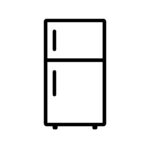Appliances and Products
Reducing greenhouse gas emissions that drive global warming and climate change like CO2, can start with choosing appliances that use less energy and making simple behavioral changes that help reduce energy use and waste. Appliances such as clothes washers and dryers, refrigerators and freezers, dishwashers and even water heaters can be some of the largest consumers of energy in your home. Choosing more efficient appliances and replacing your hot water heater with a more efficient model like an electric heat pump water heater can reduce your home’s carbon footprint and help save you money on your energy bills.

Refrigerator-Freezer Energy Saving Tips:
- Set the temperature at 35˚–38˚F for refrigerators and 0˚F for standalone freezers for long-term storage.
- Keep the doors closed as much as possible.
- Make sure your refrigerator door seals are airtight. Test them by closing the door over a piece of paper or a dollar bill so it is half in and half out of the refrigerator. If you can pull the paper or bill out easily, the latch may need adjustment, the seal may need replacing, or you may consider buying a new unit.
- Cover liquids and wrap foods stored in the refrigerator. Uncovered foods release moisture and make the compressor work harder.
- Regularly defrost manual-defrost freezers and refrigerators; frost buildup decreases the energy efficiency of the unit. Don’t allow frost to build up more than one-quarter of an inch.

Dishwasher Energy Saving Tips:
- Only run the dishwasher when it is full (not overloaded).
- Let dishes air dry instead of using your dishwasher’s heated dry setting.
- If your dishwasher has an internal heating element that boosts water
temperature (check the manual that came with your dishwasher), set your home’s water heater to 120°F.

Other Kitchen Energy Saving Tips:
- Keep range-top burners and reflectors clean; they will reflect the heat
better, saving energy.
- Cover pots and pans when you cook. The food cooks faster and you’ll use less energy.
- Use small appliances such as toaster ovens, electric pressure cookers, microwave ovens, or convection ovens for small meals rather than your large stove or oven. They will save energy and can save on cooling costs in the summer because they generate less heat.

Laundry Energy Saving Tips:
- Using warm water instead of hot can cut a load’s energy use in half, and using cold water will save even more.
- Try to wash full loads and use an appropriate water setting if you must wash a small load. Use the high-speed or extended spin cycle to remove as much moisture as possible before drying.
- Consider air drying on clothes lines or drying racks.
- Dry towels and heavier cottons separate from lighter-weight clothes.
- Heat pump dryers can save 20%– 60% more than conventional clothes dryers; consumers who use a dryer a lot and have high electricity rates have the greatest potential for cost savings. Heat pump dryers take in ambient air, heat it, and recirculate it in the dryer. Moisture is drained through a condenser to prevent heat loss. There is no need for a vent, but you will need a way to drain the water; sometimes the clothes washer drain can be used for this.

Reducing Water Heating Costs:
- Insulate your hot water tank (follow manufacturer recommendations) and hot water pipes.
- Install heat traps on the hot and cold pipes at the water heater to prevent heat loss. Most new water heaters have built-in heat traps.
- Drain a quart of water from your water tank every 3 months to remove sediment that impedes heat transfer and lowers the efficiency of your heater. Follow the manufacturer’s directions.
- Consider replacing your water heater with a more energy efficient model such as a tankless water heater, heat pump water heater or solar water heater.
REBATES & INCENTIVES
Homeowners in need of furnishing their home or replacing an appliance can take advantage of available REBATES for eligible ENERGY STAR certified appliances and products such as clothes washers and heat pump dryers, dishwashers, heat pump water heaters, freezers, air purifiers and dehumidifiers. ENERGY STAR certified appliances use up to 20% less energy than non-certified appliances.
For more information:
